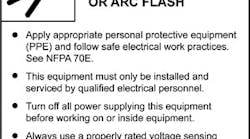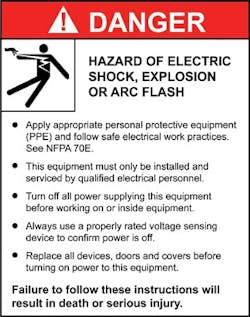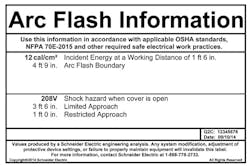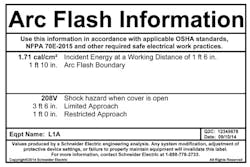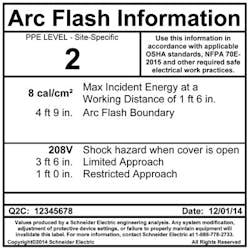Complying with the requirements of NFPA 70E®, the National Fire Protection Association’s Standard for Electrical Safety in the Workplace, is a multi-faceted process and is the responsibility of the facility owner. Each of the five requirements shown in the sidebar is interdependent (i.e., having an arc flash risk assessment performed would be worthless without having labels properly applied to communicate potential life-saving information).
Required steps to comply with NFPA 70E
- Develop and audit an Electrical Safe Work Practices (ESWP) policy.
- Conduct an arc-flash risk assessment to determine the present degree of arc-flash hazards and apply associated equipment labeling.
- Ensure adequate supplies of personal protective equipment (PPE) and proper tools.
- Conduct regularly scheduled safety training and audits for all electrical workers.
- Maintain all electrical system components.
An arc-flash risk assessment is required for any electrical equipment operating at 50V or greater that may require inspections, adjustment, servicing, or maintenance while energized. Equipment that falls into this category is required to have the field marking (label) in place.
An arc-flash risk assessment is also required even if it is a company’s practice to work only on de-energized equipment. Why? Because until the circuit is verified dead, it is considered energized. To approach the circuit to test it, the worker must be outfitted in the appropriate level of personal protective equipment (PPE); this level is specified on the label.
Arc-flash labeling requirements were first introduced in the National Electrical Code® (NEC®) in 2002 and subsequently appeared in NFPA 70E in 2009. While both standards require arc-flash labels, there are some differences in their specific requirements.
NEC labeling requirements
NEC Section 110.16 requires labeling that provides a general warning against arc-flash hazards. Changes to the NEC labeling standard have been made with subsequent revision cycles (2005, 2008, 2011, and 2014). NEC labels should contain "signal" words, colors, and symbols and should comply with ANSI Z535, which has been adopted by OSHA. Messaging should include specific details on:
- The nature of the hazard
- The consequences of the hazard
- Avoidance procedures
NEC labeling requirements also are referenced in Section 110.21(B). Because NEC labels do not contain circuit-specific information, they can be either field- or factory-applied.
NFPA 70E labeling requirements
NFPA 70E labels provide detailed, site-specific information on the arc-flash hazard present; this is useful for PPE selection. NFPA 70E labeling requirements, found in Section 130.5(D) of the standard, state that equipment that is likely to be examined, adjusted, serviced, or maintained while energized shall be field-marked with a label containing all of the following information:
1) At least one of the following:
- Available incident energy or required PPE category
- Minimum arc rating of clothing
- Site-specific level of PPE
2) Nominal system voltage
3) Arc-flash boundary
As a recommended best practice, consider adding information such as the date, calculation method, references to standards, an engineering contact, and shock boundary information.
NFPA 70E labeling options
NFPA 70E-2015 Section 130.5(D) gives facilities choices in ways to communicate the incident energy level and/or required PPE. Whichever labeling option a facility selects, consistency in using it is key.
1. Minimum arc rating of clothing
This option potentially allows for development of a simplified arc-flash PPE approach in the facility. For example, consider the PPE system defined in NFPA 70E, Annex H, where arc-rated clothing recommendations are provided for locations that have available incident energy less than 1.2 cal/cm2, between 1.2 and 12 cal/cm2, and between 12 and 40 cal/cm2. Under such a system, a worker at a location with a calculated incident energy level of 4.5 cal/cm2 would wear clothing rated for up to 12 cal/cm2.
When utilizing this approach, workers in some cases might have to wear more PPE than would be absolutely necessary, as there could be arc-rated clothing available that exceeded the actual incident energy level but that did not meet the defined minimum arc rating.
The advantages of such a system include:
- It offers a simplified arc-flash PPE system using a standardized two- or three-level PPE approach.
- It results in increased efficiency and fewer errors in label application, thanks to the use of fewer unique labels.
Finally, because the actual incident energy levels are not shown at each location but are essentially “rounded up” to the next-higher standard value, minor changes in the system would not invalidate the labels nearly as often as they otherwise might. For example, if a change in the utility system meant that the calculated 4.5 cal/cm2 incident energy value rose to 5.2 cal/cm2, the same 12 cal/cm2 minimum arc rating would still apply. See the example shown in Figure 1.
2. Available Incident Energy or Arc Flash PPE Category
With this option, the equipment is labeled with either the available incident energy level calculated in an arc-flash study or the PPE category determined using the NFPA 70E Tables. A sample image of a label showing the available incident energy is shown in Figure 2 below.
3. Site-Specific Level of PPE
NFPA 70E also allows for labels to show required “site-specific” levels of PPE. Site-specific levels are not defined in NFPA 70E but are intended to be developed by end users who wish to implement a site-specific PPE system to ensure that:
- The labels they affix to their equipment are consistent with their overall Electrical Safety Program and worker training, or
- The labels define specific PPE requirements for the facility.
A site-specific label, shown in Figure 3, could also be used to closely match “legacy” labels generated under previous versions of NFPA 70E. Though NFPA 70E does not provide further guidance on defining the site-specific options, Schneider Electric recommends that any such labels align with the facility’s written Electrical Safety Program and that workers be trained to read, interpret, and properly apply the information contained on the labels.
Conclusion
It is critical that the labeling approach, the employee training program, and the Electrical Safe Work Practices policy and documentation all align. The ultimate goal of arc-flash labeling is to allow a qualified employee to correctly understand, interpret and apply the information on the arc-flash labels. Schneider Electric’s current practice is to provide two labels – the “Danger” label to comply with NEC along with the NFPA 70E “Arc Flash Information” label. Together, the two labels constitute an effective labeling system that meets the requirements of both standards.
